Now that we’ve had the key trade shows for the UK’S wide-format digital print sector we thought we’d bring you up to speed with product introductions made in the first half of the year.
Investment by the UK’s large-format print companies in new kit and software is looking tight. Two thirds of those who responded our 2023 Widthwise survey said they’d be spending less this year than they did in 2022 (you’ll get the full analysis in the Widthwise Report published alongside the next Image Reports) - so how are manufacturers going to tease money out of you? Well, here’s a round-up of the key launches and significant upgrades brought to market during the first half of 2023. It’s not an exhaustive list of all that’s new - we could add system ‘updates’ ad infinitum - but it should give you a better idea of what’s now out there.
Agfa
The Onset X3 HS made its European trade show debut at Fespa Global in May where it was demonstrated with a three-quarter automation set-up featuring a lay table and an unloading robot. The page-wide, flatbed inkjet printer, running on new Agfa inks, and driven by Agfa’s Asanti workflow software, is capable of 24/7 printing on various substrates at speeds of up to 1450m²/h. Its uptime is due to its 30-second job setup using robotics and a number of automated features.
Agfa also showed the Jeti Tauro H3300 UHS LED at the event, having been recently been upgraded with a varnish option for flood or spot application. And the company introduced the Flex RTR roll-to-roll printing module for the Tauro H3300 LED. The module - which doesn’t have to be undocked when transitioning from rolls to boards or sheets - was developed to match the one-pass printing mode on the Tauro H3300 UHS LED, up to a printing speed of 905m²/hr. With the ability to handle both single- and dual-roll printing, the Flex RTR module can accommodate widths of up to 3.3m and 1.6m, respectively, with a maximum roll diameter of 400mm and a weight of 450kg for each roll. To ensure accurate double-sided printing, an integrated camera system reads QR codes generated by the printer’s user interface to pinpoint the exact image location and adjust the print position at the start of each job.
Also worth noting is the Asanti workflow software v6.0. It includes automation features like job ganging and packaging production-specific tools to improve efficiency. It also introduces a new feature named SureTone, which guarantees that print runs will appear identical, even if they are conducted several months apart. SureTone’s first focus is on the industrial laminate flooring market.
Canon
Canon used Fespa Global to add two new models - the 1.25 x 2.5m GTF and 2.5 x 3.08m XTF - to its Arizona 1300 flatbed printer series. The new models retain the VariaDot printing technology and both use Canon’s Flow zone-free vacuum system for easy media handling and offer multi-board and double-sided printing. The Arizona 1300 series with Flow technology also includes an API providing data about ink consumption and production times.
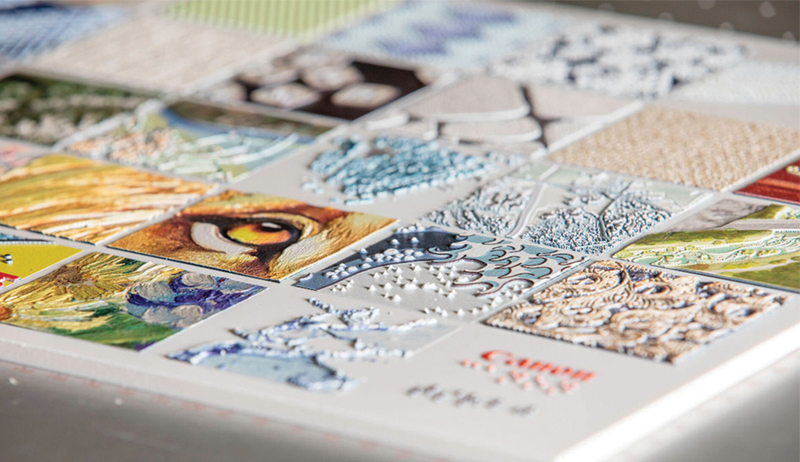
Raised print sampleboard showing Canon’s Prismaelevate XL potential
New print modes have been added for the Arizona 1300 series with the Flow technology. These include Quality-Smooth, Production-Plus and Quality-Plus (available for 8-channel configurations). The additional ‘Plus’ modes also allow users to achieve a larger colour gamut with light cyan, light magenta and white inks.
At Fespa Global Canon also launched Prismaelevate XL that enables the creation of tactile print applications, including Braille, on Arizona printers. This succeeds Arizona Touchstone and delivers twice the raised print elevation - up to 2mm - at up to 20% higher speeds on Arizona 1300 and 2300 flatbeds. There’s an Adobe Photoshop and Illustrator plugin, that requires no extra training to use, for 3D design of elevated print projects.
These latest additions come on the back of key developments earlier in the year. In March we saw the unveiling of the Colorado M-series, Canon’s first roll-to-roll large-format graphics printer platform with scalable speed configuration and media handling. The 1.6m-wide M-series comprises the Colorado M3 or M5, with cruising speeds of 29m²/hr and 40m²/hr, and top speeds of 111m²/hr and 159m²/hr respectively. There’s the option to upgrade from one speed to the other either temporarily or permanently. Both printers can also be easily upgraded to M3W and M5W models with a new Canon UVgel white ink option, as well with FLXfinish+ matte/gloss print technology for CMYK prints.
Users can automate the print-to-finish process with a UVgel Print Factory or UVgel Wallpaper Factory configuration. The new printers are supported by the makeready software Prismaguide XL.
A month after the Colorado M-series Canon UK launched Prismacolor Manager, a cloud-based, colour management software that enables PSPs to measure and validate colour across Canon and non-Canon CMYK inkjet and toner printers over multiple locations.
ColorGate
ColorGate’s Productionserver 23 includes a number of updates to the colour management and Rip solution, highlights of which include: compatibility with Adobe PDF Print Engine 6.1;automation with REST API; automated colour correction for every workflow via ColorGate’s Fingerprint technology, whereby digital samples can be created from raster data and, in the new version 23, also from PDF files; and improved UI and support access with users now able to access ColorGate’s technical support directly out of the Productionserver software.
Durst
Durst used Fespa Global to spotlight its fastest roll-to-roll printer - the new 3.5m-wide P5 350 HSR achieves print speeds of up to 670m2/hr. The LED machine can be equipped with a master roll which can feed rolls up to 1,000kg and 635mm in diameter, enabling long uninterrupted printing. The model comes with double CMYK, and there’s an integrated mesh printing system. Efficiency can be increased via optional vertical and horizontal cutting units, which operate in parallel with the printing process.
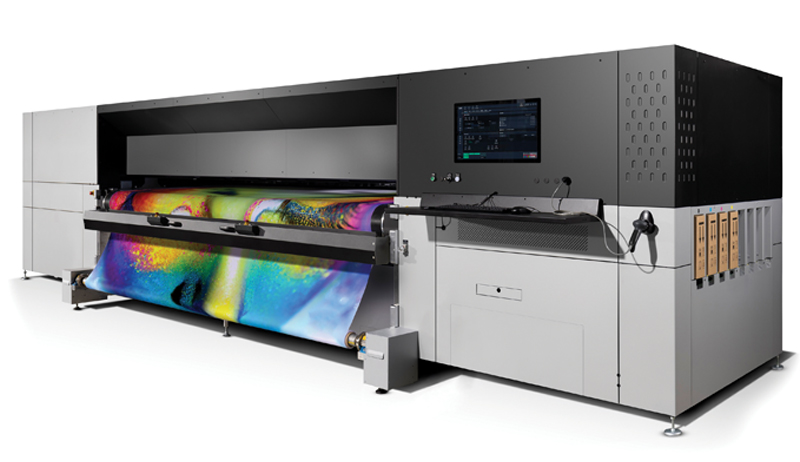
Durst’s P5 350 HSR
Following the introduction of the P5 Automat automated feeder/stacker system for flatbed printing, Durst has also entered the next stage of its P5 robotics programme. At the heart this is the flagship P5 350 HS D4 hybrid printing system, whose feeder/stacker unit is formed by two Kuka robots to enable unmanned production. The robots, modified and programmed by Durst, can pick up media from different pallets with a height of up to 180cm, feed them and stack them again separately. In the process, the printed media can also be turned 180° for reverse-side printing and fed into a second printing system. P5 robotics can also be expanded with third-party solutions or finishing systems.
Also, the VK3220T-HS UV flatbed printer from Durst’s Vanguard subsidiary got its first public outing at Fespa Global. The 3.2 x 2m flatbed printer uses up to three rows of 4 picoliter drop size Kyocera printheads at up to 1800dpi print resolution, and runs at up to 360m2/hr.
EFI
EFI has announced a 1.4m-wide Nozomi 14000 SD single-pass printer with white, orange and violet ink options in addition to CMYK and that, according to EFI, offers “speeds up to 10 times faster than multi-pass printers on the market”. The modular, base-model, four-colour Nozomi 14000 SD prints paper, synthetic media and board at speeds up to 30 linear metres per minute. At that speed, users will be able to produce up to 740 1.4 x 2.4m sheets per hour.
The base configuration of the new printer - slated for shipping later this year - features an analogue UV or water-based primer station, registration table, printer with LED curing, up to six printing bars and an advanced vision camera, and is available with several ink options, including CMYK, CMYK+W, CMYK+O, CMYK+OV and CMYK+W+O. There’s also an optional post UV or water-based analogue coater.
Alongside that announcement was that of a new EFI Transform-TF thermoforming ink. The UV LED curable ink - said to have outstanding elongation characteristics for heat bending and routing without chipping or adhesion problems - is available now for the EFI Pro 30f flatbed and EFI Vutek 32h hybrid flatbed/roll-to-roll printer models, and should be for EFI Vutek h3 and h5 printers in Q3.
Epson
Early this year Epson added 24in and 36in models to its SureColor SC-T range of large-format technical and poster production printers. It also added three 24in models to its existing 44in printer in the SureColor SC-P series.
With the new additions, the SureColor SC-Tx700 series now consists of the original 44in SC-T7700D (dual roll), a new 44in SC-T7700DL (dual roll with 1.6L ink pouches), the 36in SC-T5700D (dual roll) and three 24in models - SC-T3700E (single roll, no Adobe PostScript), SC-T3700DE (dual roll, no Adobe PostScript) and SC-T3700D (dual roll). The SC-Tx700 printers use Epson’s 6-colour UltraChrome XD3 all-pigment inks, including a new red.
The three new 24in SureColor SC-P models are the SureColor SC-P6500E (single roll), SC-P6500D (dual roll with PostScript) and SC-P6500DE (dual roll). The 44in SureColor SC-P8500DL also joins the 44in SureColor SC-P8500D to form the SureColor SC-Px500 Series.
All the printers in the series use the company’s 6-colour UltraChrome Pro6 pigment inks, which now includes an additional grey ink to broaden the colour gamut. The SC-P8500DL includes 1.6L built-in ink packs.
Also, at Fespa Global Epson showed its new SureColor F2200 DTG printer - an upgrade to its SureColor F2100 large-format printer and up to 25% faster. It comes bundled with Epson’s GarmentCreator2 for both DTG and DTF printing and uses new 800ml UltraChrome DG2 ink pouches instead of cartridges.
Elitron
Fespa Global saw a number of additions to Elitron’s cutting systems portfolio. The 3200mm wide-format Kombo SDC+ conveyor production system was demonstrated with multi-tool cutting and milling for roll materials and rigid sheets, and with the new EFS Elitron Feeding System and the new ESS Elitron Stacking System for unloading. There’s a new PMH Protective Material Handling system too, whereby sheets float from the loading stack to the working area. Note also that as of this year all Elitron systems now come with the new EPMS Elitron Power Management System to reduce energy consumption.
Enfocus
PitStop 2023 turbocharges PDF validation with the addition of FastLane, a command-line tool in PitStop Server that scans a PDF file to supply basic file information - such as page count, fonts, document properties etc. - when it first enters the workflow.
Alongside a host of bug fixes and optimisations, PitStop 2023 also brings with it JSON reports, making preflight reports faster to process and easier to interpret. It also enables easy integration of preflight reports into automated workflows to streamline the validation process even further.
Eurolaser
Eurolaser has a new intelligent solution - consisting of camera and evaluation software - for the precise cutting to existing registration marks or other material references on the large-format 3XL-3200 laser system. New, optional camera technology - called Position Plus Professional - reduces the time needed to read in the fiducial marks. The entire working area is captured via area scan, thus optimising the process time.
Fujifilm
Fujifilm launched the Acuity Prime Hybrid printer at Fespa Global and confirmed that a beta model will be installed in the UK in June, with commercial availability scheduled for the end of the year.
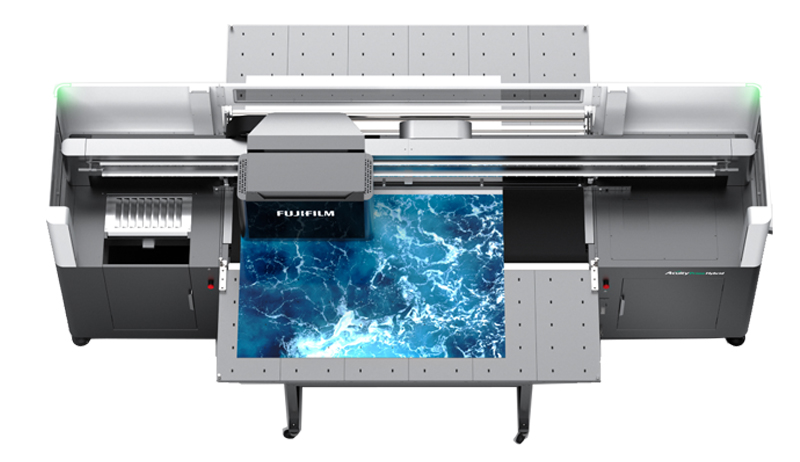
The Acuity Prime Hybrid from Fujifilm
When used as a flatbed machine, the 4-colour Acuity Prime Hybrid - which has front and back handling tables - can print on substrates up to 2m wide. It can print on up to four pieces of rigid media simultaneously, and features registration pins for precise edge to edge printing. In roll-fed mode it can be loaded with two rolls each up to 0.9m wide. Fujifilm said the Acuity Prime Hybrid, which uses Greenguard Gold certified pigmented ink, can produce print at production quality from 92m2/hr.
Fujifilm also used the Munich show to flag-up plans to bring single-pass inkjet to the sign and display market via its partnership with industrial manufacturer Barberan.
Note too that Fujifilm Acuity Prime L flatbed printer, unveiled at Fespa 2022, is now commercially available. And there are a few inks development worth flagging up. In February Fujifilm added orange, green and violet RxD pigment dispersions to its offering for water-based inkjet ink formulations and in March, it brought out new LED UV cured thermoforming inks for its Acuity Prime flatbed printers. The new Uvijet HZ inks - developed and tested at Fujifilm’s plant in Broadstairs - are free from volatile solvents and hydrocarbons, suitable for internal and external applications, and form between 150-200 degrees celsius.
InkTec
InkTec used Fespa Global to launch the FB1175 T4 large-format digital die cutting flatbed. The new Jetrix XGR320 roll-to-roll LED UV printer got its European reveal at the show too. This is a 3.2m-wide edge-to-edge printing width machine comes in CMYKWW or CMYKLcLmWW colour configurations and uses Ricoh Gen6 printheads offering printing resolutions of 726x300dpi (2-pass), 726x600dpi (4-pass), 726x900dpi (6-pass) and 726x1200dpi (8-pass). The top speed in 2-pass using the single array is 51m2/hr and 114m2/hr using the triple array. Top speed in 8-pass using the single array is 13m2/hr and 39m2/hr using the triple array. Caldera, Onyx, SAI and Print Factory Rip software is supported.
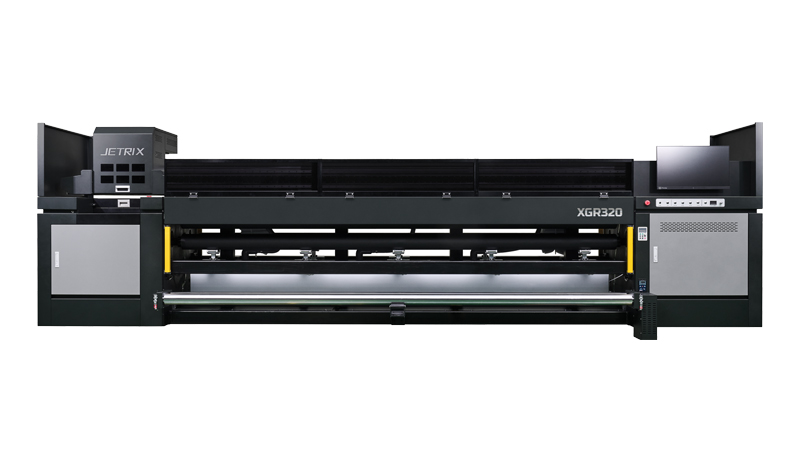
InkTec’s Jetrix XG320
Back in February the company also brought out a DTF offering comprising printer, inks, film, shaker and powder.
Mimaki
Mimaki’s first ‘direct to film’ (DTF) inkjet printer, the TxF150-75, aimed at the apparel market, debuted at Printwear and Promotion Live! in the UK at the start of the year. The company has created a range of water-based pigment inks - PHT50 - especially for this system, which is based on its 150 Series. It has a built-in ink circulation system and degassed ink pack design help prevent common DTF issues. There’s also a nozzle check unit and nozzle recovery system. The printer is supplied with Mimaki’s RasterLink7 Rip software,
Mutoh
Mutoh previewed a new flatbed CMYK, white and varnish UV LED printer with moving gantry at Fespa Global. The new printer - the XpertJet 1462UF - has a print bed of 1470 x 740mm and will print on substrates and products up to a height of 150mm. It has an integrated multi-zone vacuum bed and is equipped with two piezo drop on demand printheads mounted in a staggered setup. The first head prints CMYK, the second white and varnish, enabling 2-layer printing or Braille and 2.5D structure prints.
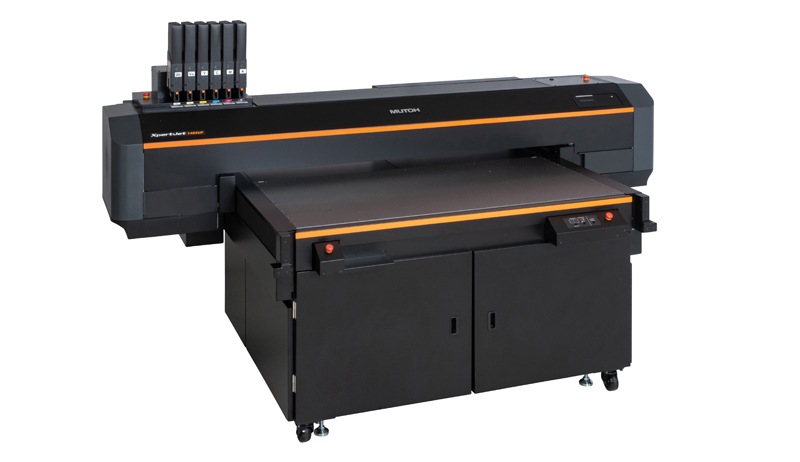
The XpertJet 146UF from Mutoh
The XpertJet 1462UF will be released later this year in the EMEA and will be offered with a new generation of soft UV LED inks compatible with a broad range of substrates and free of any SVHC (Substances of Very High Concern) ingredients.
Onyx
Onyx gave its European customers the first glimpse of its next major release software release at Fespa Global. The new version - which builds upon Onyx 22 - provides a simple way to back-up, restore, and manage print jobs for fast reprints and is expected to be globally available later this summer 2023 for the full range of Onyx solutions.
QPS
QPS has added the ColorJet Verve Mini LED UV flatbed printer to its offering. Featuring a bed size of 105cm x 165cm and top printing speed 5.57m2/hr, the new printer can handle substrates up to 65mm thick and offers CMYK plus white and varnish.
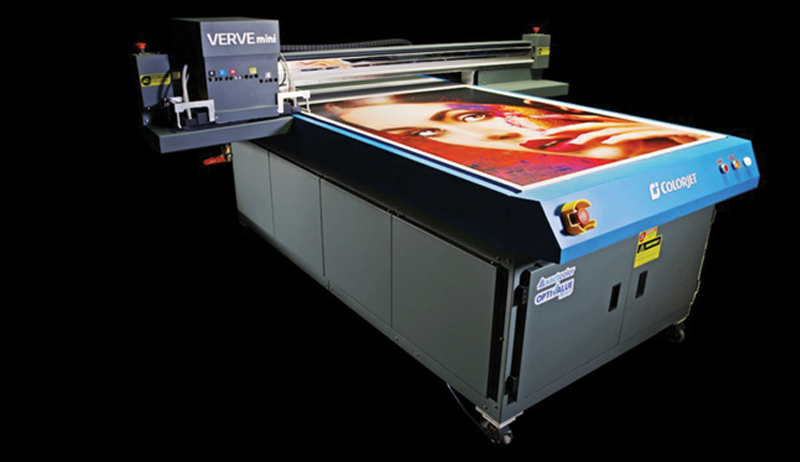
QPS has added the ColorJet Verve Mini to its offering
Roland DG
The company announced its first resin printer, the AP-640 at the start of the year amid a major extension to its TrueVis printer range which now comprises 10 models including a new LG and MG series.
The TrueVis AP640 has a maximum print width of 63.5in and accepts media 10.2in - 64in in width. The print resolution is 1200dpi, with printheads arranged in a dual, staggered formation with an optimizer printhead that preps the media surface. It uses Greenguard Gold certified TrueVis Resin Inks and comes with VersaWorks 6 Rip software and Roland DG Connect print operation app.
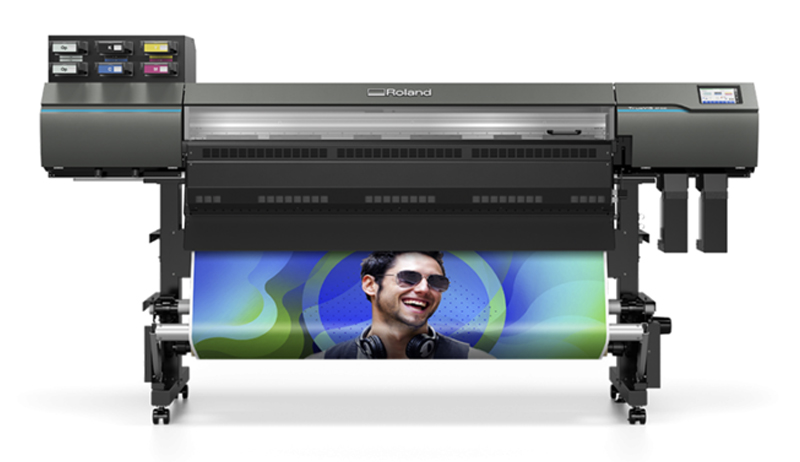
Roland DG’s first resin printer, the AP-640
There are five UV-LED print and cut devices in the new LG and MG series - the LG-640, LG-540, LG-300, MG-640 and MG-300 - offering print widths of 64, 54 and 30in. Apart from CMYK the inks choice includes white, red, orange and a gloss and primer, all Greenguard Gold certified. Again, the VersaWorks 6 Rip software and Roland DG Connect app are included.
In March, Roland DG also launched a number of new wide-format printers, including the EU-1000MF. This UV flatbed printer has a four zone electronic vacuum bed with alignment pins and can print onto substrates up to 2,440mm x 1,220mm and with a maximum height of 95mm. The maximum print resolution is 720 x 1,200dpi. It can be configured as a 4-colour machine (CMYK) or 6-colour (CMYK, white and gloss) and uses Greenguard Gold-certified E-US UV inks, available in 1l bottles. The 2.5l ink tanks can be filled on the fly. A SAi FlexiPrint Plus Roland DG Edition Rip comes as standard.
Lately Roland has unveiled a cloud service that automatically maps incoming jobs to related jigs and output devices.
Vism
The Spring 23 software updates to this wide-format print and signage installation job management software includes new features on both its web-based dashboard, used by project and installation managers to schedule and manage installations, and its mobile apps for installers and subcontractors to receive and report back on jobs.
A new drag-and-drop calendar helps manage installers’ schedules with users able to assign jobs, change dates and times or reallocate work to a different crew, either in-house or external, in a single movement, whilst everybody that needs to know is kept up to date with instant notifications.
Those running large campaigns can make use of a new campaign builder, which allows users to book jobs into the system, book individual visits for each one, share important documentation, and allocate groups of jobs to installers within a few minutes.
For those already with an MIS or ERP system, Vism’s new API eliminates the double-entry of data by allowing them to connect the two systems and send installation jobs directly to Vism, whilst its Zapier integration allows the user to connect Vism with more than 5,000 other tools used elsewhere in their business.
Vivid
Vivid unveiled its Easymount Hybrid laminator/applicator at Fespa Global. The modular system incorporates both a traditional roll-fed laminator and a flatbed applicator and incorporates patented hover technology.
Zund
New from Zund is the Q-Line with BHS180 board handling system and undercam for pallet-to-pallet automation. The integrated system solution is intended for the demands of industrial finishing of printed boards for displays and packaging. Working together, the new machine components generate a speed of up to 2.8m/s. Acceleration of up to 2.1g is made possible by a new, linear drive system. The new substructure for Q-Line cutters is made from concrete to ensure optimum cutting precision even at extremely high speeds.
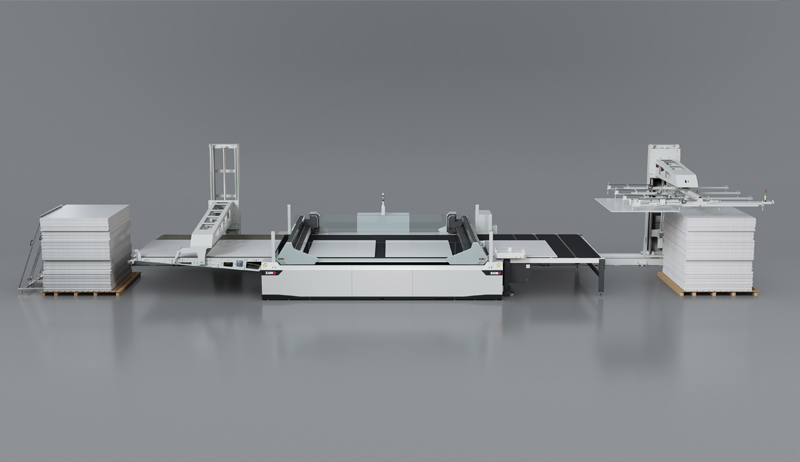
Zund’s Q-Line with BHS180
The Q-Line with BHS180 comes with Automo L, providing a creasing pressure of up to 50kg. This makes it suitable for creasing with large crease wheels such as the Creto 150. Other tools include Unito, used with centered and off-centered drag knives and suitable for processing materials up to 5mm thick. A Tomac Tool Management Client takes care of tool management, digitally linking the tools with presets. The Q-Line with BHS180 captures information stored for each job using QR codes and thus ensures an intelligent production workflow.
In addition to the hardware new Q-Line with BHS180 comprises software, such as the latest Zünd Cut Center, Version 4.0, or the Zund Connect production monitoring and analysing tool, as well as a selection of consumables.
In an initial phase, the new Q-Line with BHS180 is available as a dual-beam system in three different sizes - the Zund Cutter Q 32-32 D has a working width of 3.2m, the Q 22-32 D a working width of 2.2m, and the Q 18-32 D a working width of 1.8m.


